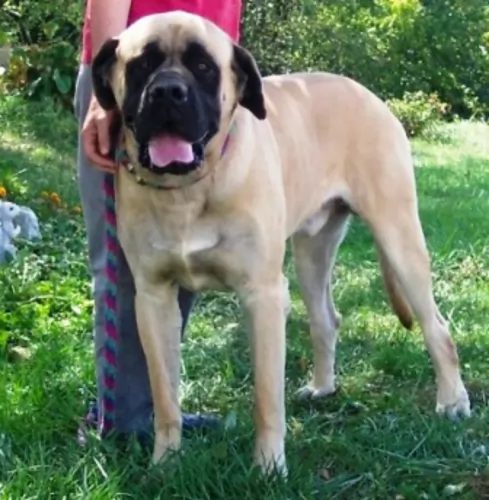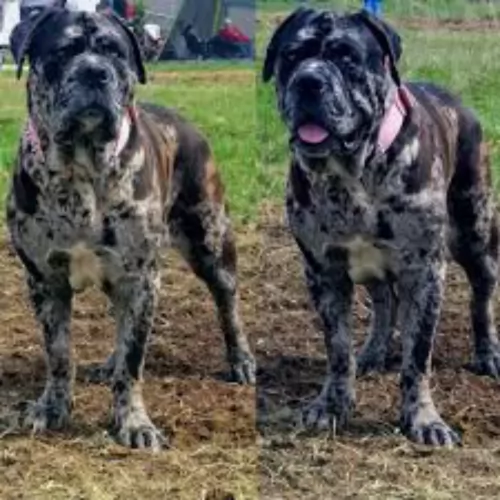 Petzlover
PetzloverBoth American Mastiff and Beagador are originated from United States. American Mastiff may grow 31 cm / 13 inches higher than Beagador. American Mastiff may weigh 72 kg / 159 pounds more than Beagador. American Mastiff may live 3 years less than Beagador. Both American Mastiff and Beagador has almost same litter size. American Mastiff requires Low Maintenance. But Beagador requires Moderate Maintenance
 The history of the American Mastiff is entirely tied to the old European Mastiffs but in particular the English Mastiff. The developers of the American Mastiff crossed the English Mastiff with the Anatolian Mastiff at the Ohio kennel, Flying W Farms. The founder of this breed is Fredricka Wagner. Because of this the English Mastiff and the American Mastiff look very much alike. The difference between the two is that the American Mastiff was bred to have less health concerns than the English Mastiff and without the drooling. In 2000 the CKC acknowledged that the American Mastiff and the English Mastiff were separate breeds.
The history of the American Mastiff is entirely tied to the old European Mastiffs but in particular the English Mastiff. The developers of the American Mastiff crossed the English Mastiff with the Anatolian Mastiff at the Ohio kennel, Flying W Farms. The founder of this breed is Fredricka Wagner. Because of this the English Mastiff and the American Mastiff look very much alike. The difference between the two is that the American Mastiff was bred to have less health concerns than the English Mastiff and without the drooling. In 2000 the CKC acknowledged that the American Mastiff and the English Mastiff were separate breeds.
The Beagador, the gorgeous medium size dog, is a mix of two beautiful breeds: Labrador retriever and a Beagle. This mix was made on purpose in the USA and resulted in a breed that got all the best of both breeds. The Beagador is an intelligent dog, very good in sports and very sociable. This made him very popular around the globe and one of the most desirable dog pets.
 This crossing of the English Mastiff and the Anatolian Mastiff resulted in a Mastiff with a much drier, less drooling mouth than the other Mastiffs. This is a giant, massive dog – powerful and muscular. With a wide head that is rectangular rather than square. Their eyes are dark amber, and their ears are high on their head and rounded. With a medium size muzzle, black mask and heavy head, the American Mastiff is a handsome dog.
This crossing of the English Mastiff and the Anatolian Mastiff resulted in a Mastiff with a much drier, less drooling mouth than the other Mastiffs. This is a giant, massive dog – powerful and muscular. With a wide head that is rectangular rather than square. Their eyes are dark amber, and their ears are high on their head and rounded. With a medium size muzzle, black mask and heavy head, the American Mastiff is a handsome dog.
Their chest is broad, deep with ribs that extended backward. He has strong legs that are parallel and wide set. He also has a long tail. Puppies of the American Mastiff are born almost black and as they grow their coat color lightens. In addition, it is important that they have a wrinkled forehead as well and a scissors bite is preferred.
The Beagador got his height genes from the Beagle. That means that he is a bit shorter than the Labrador. Generally, they look a lot more like the Labrador, but in some cases, the puppies actually look more like a Beagle. So, actually, there is no rule about this. They have the short coat, usually very smooth. Sometimes it turns out softer and sometimes it doesn’t. They come in many colours, and they are usually two-coloured. So, the real truth is that Beagador breed appearance depends on the stronger genes between parent mix of Beagle and Labrador.
 A love of children and devotion to his pack (family) is bred into the American Mastiff. He is non-aggressive unless you threaten his family or his children. Then he becomes courageous, protective and defensive. This is a gentle giant most of the time, however due to size and the need for strong leadership, the American Mastiff should be socialized and trained early. If they are socialized and trained they will be calm, gentle dogs. They will remain protective and alert, but they will be friendly with strangers. They love to please their people and being highly intelligent they learn fast.
A love of children and devotion to his pack (family) is bred into the American Mastiff. He is non-aggressive unless you threaten his family or his children. Then he becomes courageous, protective and defensive. This is a gentle giant most of the time, however due to size and the need for strong leadership, the American Mastiff should be socialized and trained early. If they are socialized and trained they will be calm, gentle dogs. They will remain protective and alert, but they will be friendly with strangers. They love to please their people and being highly intelligent they learn fast.
The Beagador is a friendly breed. They will make no difference between adults and children, and they will bond easily even with complete strangers. But, children are usually more active than adults, so, in situations where he can choose, he will definitely choose to play with children. Some say that this dog never grows up in his heart. Maybe that is the reason they like children more.
Hunting, sports
The Beagador has the sweetest temper. But, for him, everything is a game. He might be a little bit too happy for other dog breeds. He likes to chase, jump, wrestle and be very physical with other animals. Some animals will enjoy this, but most of them won’t. If you start training him while he is still a puppy and socializing him from his early days, he will learn how to fit in and take a break once in a while.
The Beagador is very intelligent breed. They will be easy to train but only if you are experienced teacher. If you are not, they will try to get the things on their own way and you will end up being trained. It is advisable to use the reward technique, but make sure you don’t prise your Beagador with food. Early training is a must.
 American Mastiffs seem to have fewer health issues than other larger giant breed dogs. However, they can experience allergies as many large, wrinkled dogs do. They also might have a tendency toward eye issues, hip dysplasia, cancer and heart disease. Bloat might be the most life-threatening issue many American Mastiffs experience.
American Mastiffs seem to have fewer health issues than other larger giant breed dogs. However, they can experience allergies as many large, wrinkled dogs do. They also might have a tendency toward eye issues, hip dysplasia, cancer and heart disease. Bloat might be the most life-threatening issue many American Mastiffs experience.
The problems with their third eyelid, high risk of corneal wounds since they get too playful all the time, a disease that causes the dysfunction of the tear glands, conjunctivitis, glaucoma, cataracts, blindness.
When the puppies are born with skeletal defects that causes them to remain small.
Atopic dermatitis – very dry skin. If not treated, it will result in wound made by scratching the itchy and dry skin.
Since they have dropped ears, they don’t have the natural airflow and that causes the most of the infections.
 Giant breeds like the American Mastiff are known for growing rapidly as a puppy and therefore proper feeding and nutrition is essential. The slower your American Mastiff grows, the better. Make sure your puppies get enough phosphorous and calcium in their high calorie diet. Free feeding is not recommended. Feed puppies up to 4 small meals per day and feed adults twice a day.
Giant breeds like the American Mastiff are known for growing rapidly as a puppy and therefore proper feeding and nutrition is essential. The slower your American Mastiff grows, the better. Make sure your puppies get enough phosphorous and calcium in their high calorie diet. Free feeding is not recommended. Feed puppies up to 4 small meals per day and feed adults twice a day.
As previously mentioned this breed is a fairly healthy one, There, are however, certain evaluations you should do with your American Mastiff puppy to be sure she is in good health. These tests would include an elbow and hip evaluation to check for dysplasia. He should have an ophthalmologist and cardiologist examine him as well. Most American Mastiffs will not have any problems, but these evaluations will help to prepare you if they do. The wrinkles in your dogs; face, around the eyes and muzzle must be kept clean as they can become infected if you don’t.
Unlike the way he looks, the American Mastiff is not a couch potato, but neither are they a high energy, exercise machine. They do well living in apartments or homes, with or without a fenced in yard. They need a long walk every day. They need mental stimulation through exercise and games. Make sure they learn to love to play so that they don’t become lazy as they age.
One of the first things you will notice is – you will never be able to feed your Beagador. He is always hungry, and he can always have just one more bite. But, this usually leads to very dangerous obesity. Make sure you feed him with prescribed portions: three times a day until he is 6 months old, and two times per day once he grows up. Their diet must be sugar-free.
The Beagador is one of the lovable breeds. They need a lot of love and they show a lot of love. They have playful nature and they get happy just by being with people. They shouldn’t be left alone for too long because they will easily develop the separation nervousness. They like to eat and they will use any chance to beg for food. That makes them very obese in no time. Keep in mind that giving them the prescribed proportion is for their own good. They need moderate grooming since they shed regularly. If you bathe them once in a month and brush them two times per week, they will do just fine.
The Beagador is a very active dog. They need daily activity. Since they are very friendly, you will have a great chance to meet a lot of people at the dog park! They will run with you, run along while you drive your bike, play in the water, fetch.